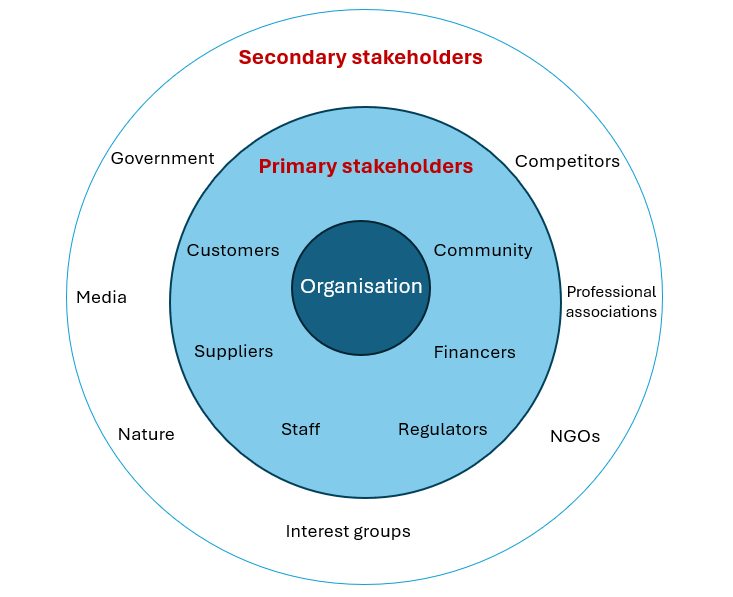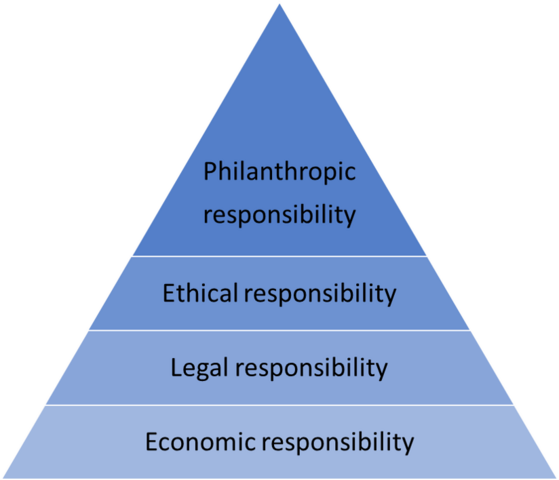Chapter 2: Social responsibility
Definition
Capitalism: An economic system characterized by private ownership of the means of production, where individuals and businesses operate for profit within a competitive marketplace.
- Self-Interest Driven: Individuals and businesses act primarily out of self-interest, but the free market system can still lead to beneficial outcomes for society.
- Private Ownership: Individuals and companies own resources and businesses.
- Profit Motive: The primary goal is to generate profit, driving innovation and efficiency.
- Market Competition: Businesses compete to attract consumers, influencing prices and quality.
- Supply and Demand: Prices fluctuate based on consumer demand and the availability of goods and services.
- Economic Growth: Can lead to increased productivity and improved living standards.
- Critiques: Concerns include income inequality, environmental degradation, and potential monopolistic practices.
Capitalism, with its emphasis on market competition and profit maximization, has often been criticized for prioritizing short-term gains over long-term societal well-being. However, the integration of social sustainability into capitalist frameworks presents a transformative opportunity. By prioritizing ethical practices, fair labor conditions, and environmental stewardship, businesses can align their profit motives with the needs of communities and ecosystems. This approach fosters innovation and resilience, encouraging companies to adopt sustainable practices that not only enhance their brand reputation but also contribute to the overall health of society. Ultimately, capitalism can evolve to support a more equitable and sustainable future, where economic growth and social responsibility coexist harmoniously.
From Shareholder to Stakeholder view
The stakeholder view shifts business purpose from maximizing shareholder profit to creating shared value across a wider network of relationships. Rather than focusing solely on financial returns, it emphasizes social sustainability—ensuring that organizational practices support equity, well-being, and long-term resilience for people and communities. This perspective recognizes that businesses do not operate in isolation but are embedded within social and environmental systems, and their legitimacy depends on contributing positively to both.
Within this model, primary stakeholders—such as employees, customers, suppliers, and investors—are vital to the organization’s daily functioning and long-term survival, while secondary stakeholders—including communities, advocacy groups, media, and civil society—shape broader perceptions of corporate responsibility. Addressing the needs and concerns of both groups supports not only business continuity but also social cohesion, trust, and inclusivity, reinforcing the role of business as a partner in advancing sustainable futures.

Under capitalism, stakeholder consideration has become increasingly vital as businesses recognize that their success is intertwined with the interests of various groups affected by their operations. Stakeholders include not only shareholders but also employees, customers, suppliers, communities, and the environment. This broader perspective encourages companies to go beyond profit maximization and consider the social and environmental impacts of their actions. Engaging with stakeholders can lead to improved decision-making, enhanced reputation, and greater trust, ultimately fostering long-term sustainability. By balancing the needs and expectations of diverse stakeholders, businesses can create value not just for themselves but for society as a whole, contributing to a more equitable and responsible capitalist system.
Corporate Social Responsibility
In relation to move from shareholder to stakeholder view, companies that prioritize CSR actively engage in efforts to promote diversity, equity, and inclusion within their workforce and supply chains. They strive to create equal opportunities for employees from diverse backgrounds and ensure fair treatment for all. Moreover, CSR initiatives often target marginalized communities to uplift and empower them, promoting social equity through various social programs and partnerships. By considering the needs of vulnerable groups and supporting projects that enhance social well-being, companies contribute to a more equitable society.
Definition
Corporate Social Responsibility (CSR): A business model in which companies integrate social and environmental concerns into their operations and interactions with stakeholders. CSR goes beyond profit generation, emphasizing ethical practices, sustainable resource management, and community engagement. It involves a commitment to conduct business in ways that are socially responsible, including fair labor practices, environmental stewardship, and philanthropy, ultimately aiming to create positive impacts on society while achieving financial success.
Carroll’s Pyramid of Corporate Social Responsibility (CSR) is a framework that outlines the different levels of responsibility that businesses have toward society. Developed by Archie B. Carroll in 1991, the pyramid consists of four tiers, each representing a different aspect of corporate responsibility:
Business practices that improve social sustainability go beyond compliance or image-building and focus on creating fair, inclusive, and supportive systems that enhance well-being for all stakeholders. Here are some important practices to nurture true social sustainability:
-
Diversity, inclusion, and decentralization – Ensuring decision-making is not concentrated in narrow groups but reflects diverse perspectives, enabling more equitable and resilient outcomes.
-
Bringing marginalized stakeholders to the table – Actively involving underrepresented voices in organizational processes to address systemic inequities and co-create just solutions.
-
Community engagement and place-based organizing – Building strong relationships with local communities, aligning business practices with local needs, and fostering long-term trust.
-
Meaningful jobs, work–life balance, and mindfulness – Creating dignified work environments that support employee well-being, reduce burnout, and promote a healthier organizational culture.
The role of individuals
What we prioritize in our life impact how we shape our society. Role of individuals in advancing social sustainability lies in rethinking priorities and everyday choices. Rather than centering life around material accumulation, individuals can emphasize what truly matters for long-term well-being—such as cultivating rich, enduring relationships, engaging in physical activity and healthy lifestyles, and fostering connections with their communities. By valuing experiences, care, and balance over consumerism, individuals contribute to a culture that supports equity, resilience, and collective flourishing.
Goodness is the only investment that never fails.
~~ Henry David Thoreau
Knowledge Check!
Resources
- Balmer, J. M., Fukukawa, K., & Gray, E. R. (2007). The nature and management of ethical corporate identity: A commentary on corporate identity, corporate social responsibility and ethics. Journal of Business Ethics, 76(1), 7-15. https://doi.org/10.1007/s10551-006-9278-z
- Sustainability Illustrated. (2021, May 28). CSR: What is corporate social responsibility? Definition examples benefits [Video]. YouTube. https://youtu.be/Zc102xiah1M?si=7Ig8USJbDjEDny_y
- Carroll, A. B. (1991). The Pyramid of Corporate Social Responsibility: Toward the Moral Management of Organizational Stakeholders. Business Horizons, 34(4), 39-48.
- ESG | The Report. (n.d.). What is social washing? ESG | The Report. Retrieved [Feb 5, 2025], from https://esgthereport.com/what-is-social-washing/
- Onbhuddha, R., & Ogata, S. (2024). The influence of stakeholder on a company’s sustainable practice: Insights from the Japanese perspective. Journal of Cleaner Production, 436, 140402.


